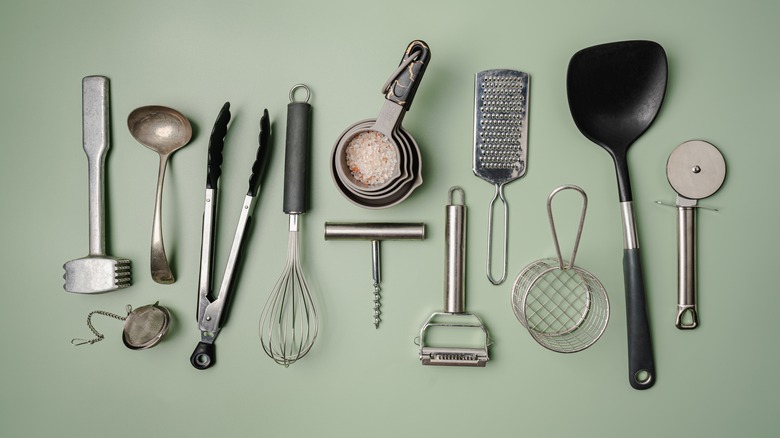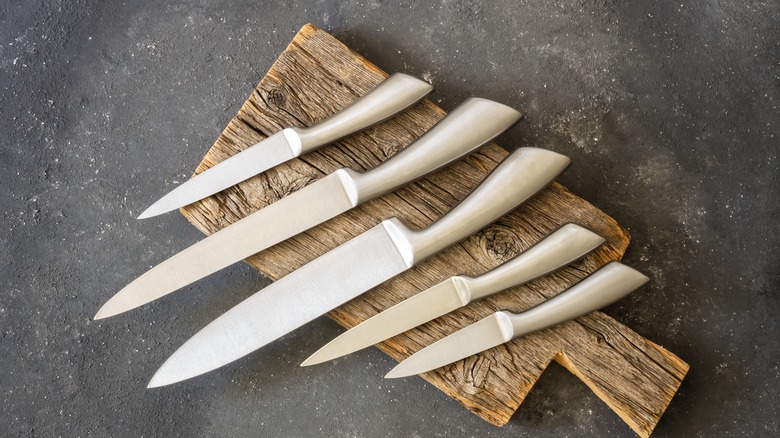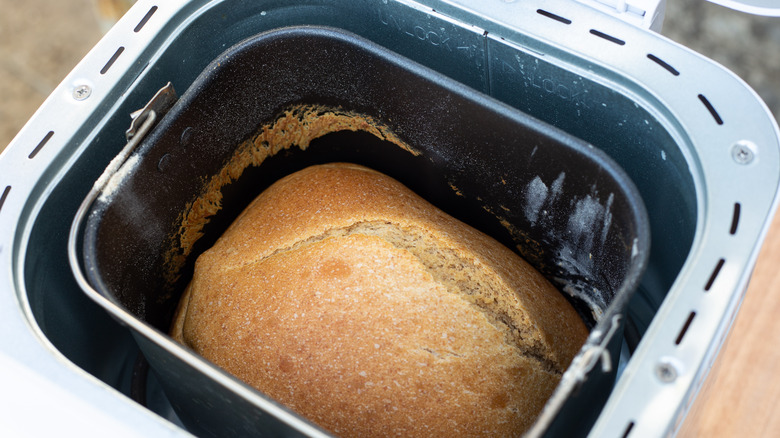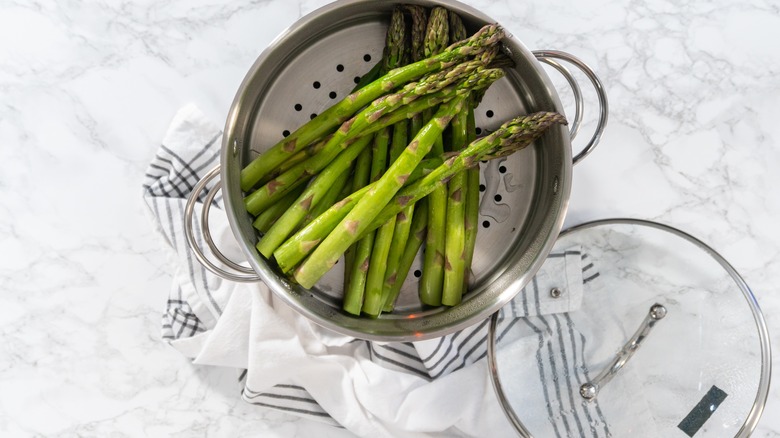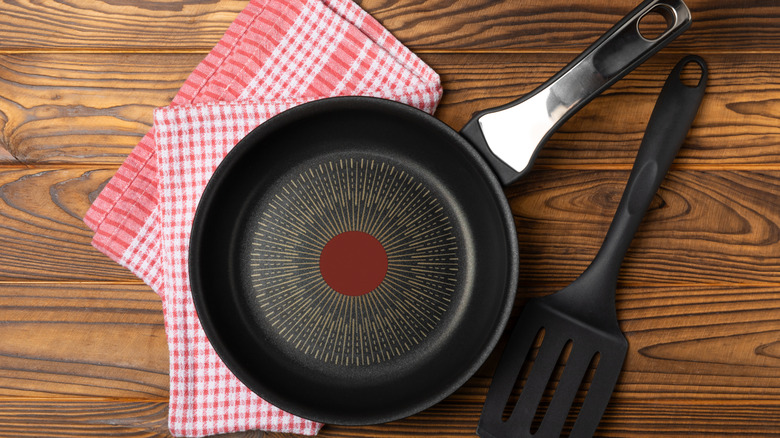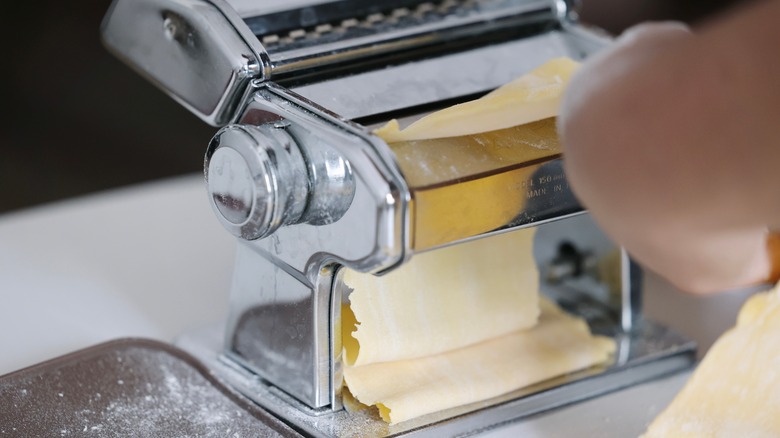10 Kitchen Gadgets You Should Stop Buying To Save More Money
Those kitchen gadgets occupying the deepest shelves in your cabinets add up to way more spending than you might think. The kitchenware market is currently valued about $9.4 billion, according to Grandview Research, and is projected to balloon to over $14 billion by 2033. All in all, people are expected to keep buying kitchen items for the home for many years to come. Yet, while many kitchen items are useful to make meal prep easy or are necessary for cooking delicious meals, some tools ultimately represent very frivolous purchases that can waste both your time and money.
It's very easy to get carried away buying kitchen gadgets for your home, especially if you tell yourself you're going to use the items way more than you actually will. Perhaps you saw an ad for a useful, but gimmicky way to slice vegetables. Or your New Year's resolution is to learn to prepare pasta from scratch. Whatever the reasons, if you're not careful, you may soon find yourself with a kitchen filled with items and utensils that won't just go unused: they'll ultimately come to represent a lot of wasted money. Imagine spending hundreds of dollars on gadgets that you don't need and whose rare usage will ultimately not justify the price paid for them. If you want to save money by avoiding unnecessary spending, here are the kitchen gadgets you can safely cross off your shopping list.
Garlic press
The garlic press is typically used to prepare the vegetable as quickly and conveniently as possible. A few presses, and you're meant to have a neat pile that can be readily added to recipes that call for pulverized garlic. If you were to look for one on Amazon, you can expect to spend between $9 and $30. That price range could sound like a bargain, especially if you're not familiar with preparing garlic. However, the garlic press is ultimately a waste of money, especially once you learn how to chop and prepare garlic for recipes properly.
Even if you choose the garlic press for convenience's sake, you may still regret the purchase. In an article on Food52 titled "Why Do People Hate Garlic Presses So Much?," the author Valerio Farris explored the shifting narrative around the kitchen gadget and the reasons people gave for avoiding them. The reasons given included finding them annoying to clean, claiming that they made garlic "taste bitter," and that all the flavorful juice remains in the press itself. Instead of buying this particular kitchen gadget, we advise you to learn the "crushing method" and spend your money on better items.
Onion goggles
It's understandable why someone would want to own onion goggles. After all, it's only natural to want to put as much distance between your eyes as those tear-inducing onions as possible. Despite their convenience, there is no real reason to buy a pair, no matter how affordable they may seem.
The onion goggles, however budget-friendly you go, can't justify their cost because there are simple techniques for chopping onions that, when used, will help alleviate the famous stinging sensation as well as avoid making your eyes water. If you didn't know, onions are rich in sulfur. When chopped, they release sulfuric compounds and enzymes as a gas, which is responsible for that annoying effect on your eyes. If you want to avoid the sting as much as possible, you can chill your onions in the refrigerator right before chopping them. You should also turn on the stove fan or open a window to create better ventilation. Lastly, the tried and true method of chopping onions underwater also helps.
Plastic straws
Plastic straws are among the most popular single-use items purchased in the United States, with Americans using millions of straws every day. This purchase is more about convenience than necessity, but what many shoppers may not realize is that single-use plastic straws are not only a waste of money, but represent serious harm to the environment. Plastic straws were among the most collected items during international marine cleanup efforts, according to the Ocean Conservancy. They are also notoriously difficult to recycle, as they are typically too small for the average recycling machine.
More worrying, the plastics that pollute the environment do more than just linger. They become microplastics that find their way into our drinking water and eventually into our bodies, potentially impacting on our overall health and development in ways that are worrying, and still not fully understood. Some might mistakenly mean that abandoning single use plastic means no more drinking straws. However, that's not remotely true.
If you're still set on a single-use and disposable option, instead of buying plastic straws, you can switch to biodegradable paper straws. If you're not a fan of paper straws or want something reusable, then stainless steel drinking straw sets may be your best bet. As long as you clean them properly, these straws can be used over and over for a long time, letting you enjoy your favorite drinks while saving money.
Kitchen knife sets
Every serious home chef has those one or two knives that are their favorites. Reliable standbys that they use for practically everything. And that is a big part of the reason why you might find that purchasing an entire kitchen knife set is a big waste of money. In the name of quality and completeness, people will often spend between $20 and $200 on a kitchen knife set. Meanwhile, some high-end sets are priced between $500 and $2,100. It would be extremely frustrating to invest hundreds to thousands of dollars into a group of knives just to realize that day-to-day, you're only really using one or two.
Instead of spending so much money on a set of items you'll likely never use, you'll probably enjoy greater savings by purchasing a very good chef's knife instead. As writer Owen Burke noted in his Business Insider opinion piece on kitchen knife sets, knife sets are often full of "filler knives" that won't get used all that often — but drive up the price of the set.
How much you are encouraged to spend on a good chef's knife depends on your needs and budget. Some of the best-selling knives on Amazon sell for $10 to $40. When professionals are asked, they may recommend you invest in a high-quality knife, but also be prepared to spend between $100 and $200, if not more. If the goal is to ensure you get a good knife that you'll always use and lasts a very long time, this is an investment that could save you a lot of money in the long run.
Bread machine
If there was a surprising trend that emerged during the COVID pandemic, it was the sudden popularity of bread making. Especially, sourdough bread. And there's little sign that this desire for homemade bread is going away any time soon. As such, it shouldn't be too surprising that many people are going out and purchasing bread making machines. This purchase trend is why the bread maker market is currently valued at around $8 billion; the value is expected to increase to $11.1 billion by 2032. Interestingly, the North American alone accounts for about 32% of market share value as of 2024. Right now, stores like Walmart sell these items for between $75 and $400.
For all the excitement around bread making, we still feel that you can enjoy this newfound hobby without needing to spend money on a machine. And there's a good reason to feel that way, as the art of bread making goes back hundreds to thousands of years, with a wide range of recipes that are achievable without a machine. Although bread makers are marketed as convenient and easy, half of the fun of making bread is the step-by-step process that lets you or your family create something delicious and fresh. Most importantly, you need not invest in a bread machine if you have access to a kitchen oven. Likewise, you can also make bread in a pan or even using a microwave.
With these tools that you likely already have access to, you can enjoy making bread while also saving some extra money. If you feel nervous about trying to make bread without this machine, take comfort in knowing it's been done for hundreds of years. The odds of you getting it right are firmly on your side.
Asparagus steamer
Asparagus is a vegetable that you'll often find in spring-time dishes, and while its popularity is debatable, its health benefits are not. According to Healthline, there are several positive reasons to include this food in your diet, such as its many nutrients, antioxidants, and that it's low in calories. But no matter how much of a fan you might be of asparagus, it's going to be hard to justify the decision to invest in an asparagus steamer.
While you might be able to use the steamer for other vegetables or purposes, the fact remains that this is an oddly specific kitchen gadget that's best suited for one task. With that in mind, it's hard to justify spending between $30 and $40 for a kitchen gadget that only has a single purpose. Added to that, even if you're a fan of asparagus, it's very unlikely you're going to be preparing this vegetable on a daily, or even weekly basis. Lastly, there are multiple ways to enjoy asparagus, and so you may find that even if you're eating it, you're not going to need to steam them every single time.
Instead of giving in to this cookware gimmick, you may be better off buying a general microwave steamer for about half the price. At the same time, there are recipes available for how to steam this vegetable with nothing more than a pan and boiling water, representing a great way to enjoy asparagus and avoid wasting money on an unnecessary purchase.
Egg cooker
Eggs remain an extremely popular food staple in the United States. As of 2025, the average American consumes about 276 eggs per year, per Statista. The egg cooker is a kitchen gadget designed to leverage that popularity. While these products are easy to find, it is really hard to justify buying one if your goal is to save money and avoid wasteful spending.
Ultimately, egg cookers are used to prepare this single food a specific way. While you have a choice of how hard or soft cook it makes your eggs, you will find that it isn't capable of preparing your egg any differently from how you can do so yourself by boiling eggs in water. You need not even invest in a kitchen timer; there are timer apps available on your smartphone. Using a good recipe and a timer, you can get your eggs to boil and achieve whatever level of hard or soft of a center you prefer.
It's also important to remember that one of the reasons eggs are so popular is that there are so many different ways to cook and enjoy them. An egg cooker is very limited in how it prepares your eggs, and you are better off opting for kitchen tools that help you explore variety. In fact, you could surprise yourself by learning techniques for free online that will make you wonder why you thought you ever needed to buy this gadget in the first place.
Non-stick cookware
The non-stick cookware craze has existed since at least the 1950s, back when Teflon-coated pots and pans were first introduced to the public. It's easy to understand why these types of cookware persist in popularity, as the name implies food will quickly and easily slide out of the pan. More importantly, these sets promise little to no mess and easy clean up, which can be seen as a major bonus for anyone that's spent a lot of time and energy preparing a big meal. Today, the cost of non-stick cookware sets will vary, depending on the material, non-stick substance, and number of pieces in the set, though we think you may be better off avoiding a non-stick cookware set altogether.
If your primary concern is avoiding having food stick to the pan, adding to your clean-up time, there are ways to get around this issue and save your money. Some useful tips include properly pre-heating your pan, keeping an eye on the overall temperature, and making use of butter or oil. It also helps to be aware of how certain foods react in the pan. For instance, foods that are high in protein but low in fat are more likely to stick to pans.
In addition to saving money, avoiding non-stick pans could also protect your health, as some of these products have ingredients known as forever chemicals that some research suggests are dangerous to humans as well as the environment.
Standalone pasta roller
The standalone pasta roller is only really going to make sense in your kitchen if you intend to constantly use this gadget to prepare pasta from scratch. For instance, rolling out lasagna noodles by hand can take anywhere from 45 minutes to an hour. That doesn't include the time needed to prep other ingredients. While this process may not be too cumbersome for occasional meals, unless you're using this roller all the time, you might find it's ultimately a waste of the $30 to $120 spent on obtaining it
Rather than going out and getting the standalone pasta roller, it's better to save money by getting your pasta pre-made. If you're not a fan of getting your pasta on the shelf, there are specialty shops that you may be able to find in town, or also online. Either way, you may find your money better spent this way than with a kitchen gadget that will inevitably find itself forgotten at the back of a closet or pantry.
Electric can opener
It's understandable why electric can openers are popular, as they are an extremely convenient way to open cans or jars with practically no effort. They're also ideal for those who have physical limitations that might make a manual can opener impractical. Aside from health-related needs, there are other options that may make plug-in electric can openers a waste of money.
When used correctly, a manual can opener will only take a few seconds; there is hardly enough time saved with an electric can opener to justify the purchase. If you are concerned with difficulty, there are easy-to-use manual openers that create smooth edges, making them a child-friendly option. There are also some automatic openers that use batteries.
Lastly, by avoiding spending money on these plug-in electrical kitchen gadgets, you may also be saving electricity. For anyone on a tight budget or fixed income, these seemingly unimportant decisions can go a long way towards reducing monthly expenses. A good manual opener can be used for years without issue or any worries relating to shorting out or wasted resources.
